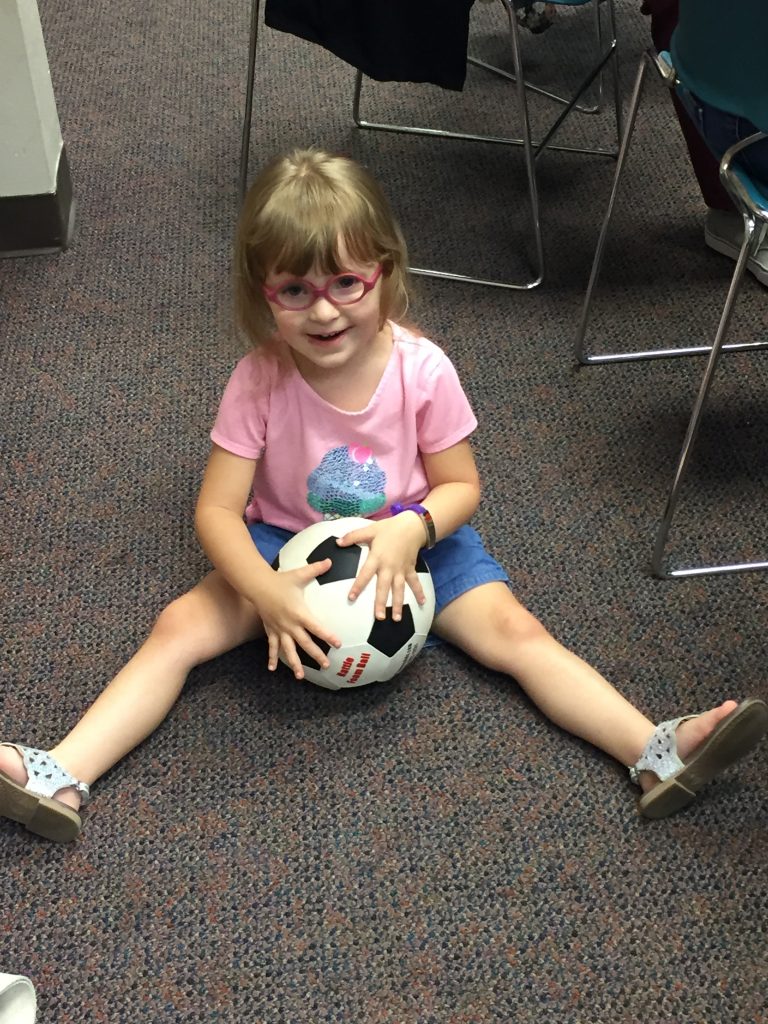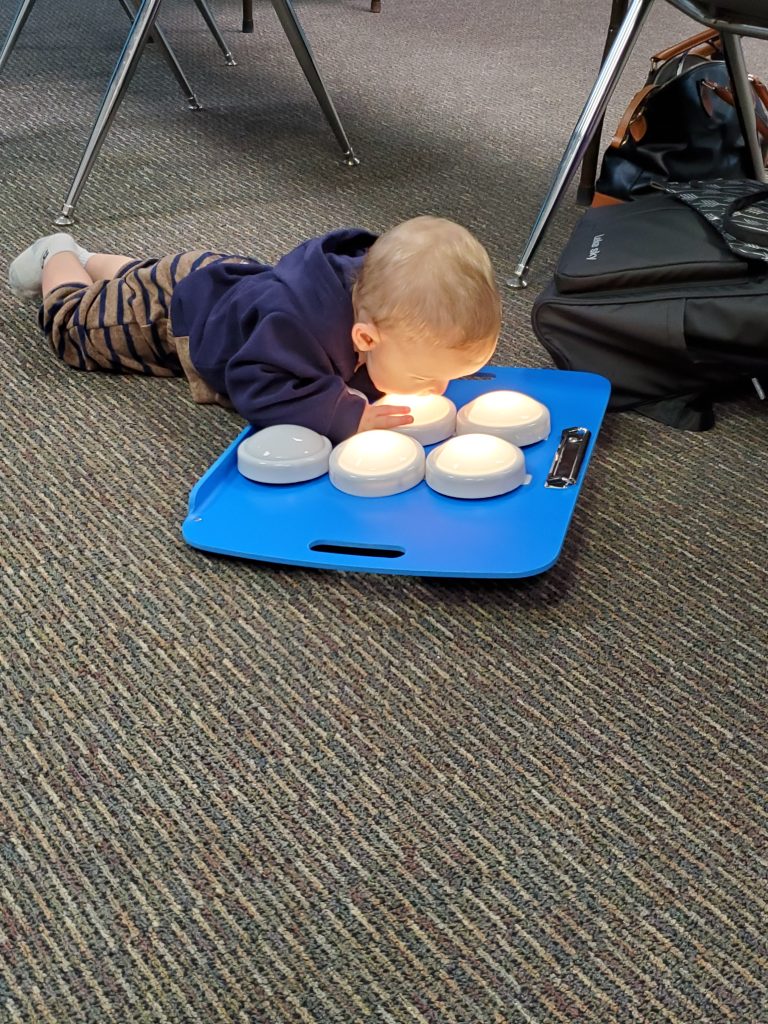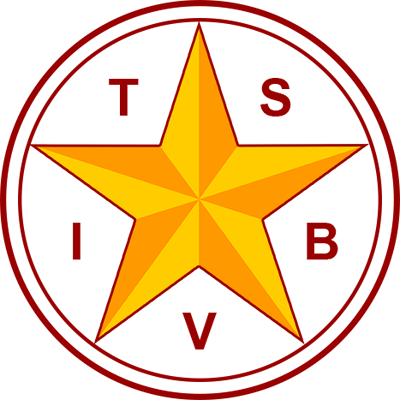Literacy for Little Ones
Authors: Renee Ellis, TSBVI Outreach Teacher, Kathi Garza, TSBVI Outreach Early Childhood Teacher, Cyral Miller, TSBVI Outreach Teacher, and Debra Sewell, TSBVI Curriculum Director
Keywords: literacy, prerequisite skills, emergent reading, child development, motor skills, tactile skills, concept development, language, communication
Listen to the Article
When does literacy begin? Understanding the world and developing the ability to communicate about it using gestures, speech, sign language, or other formats, starts with our very earliest experiences. Babies typically come into the world using vision to take in their surroundings, bond with their caregivers, and, as they grow, make connections between what they see and symbols (such as pictures or print) that represent those objects. Children who are blind or have visual impairment (VI) can develop these skills, too. Although literacy may develop differently for students with visual impairment and those with additional learning needs, child development follows recognized developmental sequences. VI professionals can help families support early literacy at home even before their child enters a classroom; experiences in the earliest years contribute to later reading success. Students who struggle with reading in school may have missed important early developmental milestones. Revisiting those lessons may help them move forward in academics. We cannot rush or skip steps!
Literacy instruction is always part of a comprehensive approach to child development. If we know that literacy starts at birth, then we can track the development of a child’s skills in underlying areas as they grow towards conventional reading success. In school, literacy instruction is typically based on the five key components identified by the National Reading Panel: phonemic awareness, phonics, fluency, vocabulary, and comprehension. This article focuses on early developmental skills that are prerequisites for formal reading instruction.¹
Beginning in 2018, the TSBVI Outreach and Curriculum Departments started designing a four-part training series called Literacy for Little Ones. Sessions were created to help build the fundamentals of literacy in young children with visual impairments by focusing on important early childhood developmental areas, including strategies for families to incorporate into home routines. Frequently, young children with significant visual impairment do not have the same rich literacy experiences as their peers and may not begin to develop foundational reading skills until they enter school. Literacy for Little Ones was developed to help professionals and families provide systematic opportunities for movement, interaction, and stimulation to infants and young children with visual impairment, especially those who are likely to be tactile learners. The series brings families together with professionals and concentrates on four specific topics:
- Gross and fine motor skills (including tactile skills for future braille readers)
- Early concept development
- Language and communication skills
- Emerging reading and writing skills
The first three areas are important to address in early childhood, because they should be well established before moving on to instruction in formal reading and writing. Some older students do not make expected progress in book skills such as tracking, identifying letters, and answering comprehension questions about stories. It’s worth taking a good look at whether they have achieved these early developmental milestones. Sometimes, delays in reading progress reflect missed mastery of important prerequisite skills. While children do need extended repetition and practice in order to succeed with reading, literacy for all readers is built upon opportunities for and mastery of foundational skills.
In 2020, TSBVI offered four Coffee Hour webinars based on the Literacy for Little Ones trainings in each of the topics below. Resources for VI professionals collected for those sessions are included at the end of this article.² Another major source for information about literacy specifically for children with visual impairment is the Paths to Literacy website.³
Part 1: Gross Motor, Fine Motor and Tactile Skills
Movement and motor activities are not just fun, they are critical for all early learners, especially those with visual impairment. Gross motor skills and early movement experiences facilitate the development of muscle tone, balance, and awareness of self in space, core strength, coordination and stamina.⁴ Children use gross motor skills to maintain stable sitting and standing positions which are later required for reading and writing, especially for students who will read braille.⁵ If sitting upright requires energy to counter gravity, or balancing the head on the shoulders takes great effort, then bringing both hands in front of the body to hold a book and track lines fluidly across a page are much more difficult. Gross motor development also serves as the foundation for mobility skills for the young child who is visually impaired, which in turn supports literacy.
Motor development progresses from gross motor movement to fine motor, including the development of tactile skills needed for turning pages of a book or reading braille. Tactile learners need fine motor skills in order to manipulate small objects, explore shapes, sort objects, and, of course, to read and write. The overall development of tactile learners, including concept development, communication, spatial thinking, and academic achievement, depends greatly on how much information these children can receive and interpret through tactile means. Frequently, tactile learners need more opportunities to develop strength in their hands and fingers before they can place their hands close together and move across a horizontal line of dots. The ability to differentiate between configurations of dots is more meaningful once a child can consistently identify real objects by touch.

Movement activities help develop literacy.
Part 2: Concept Development
Concept development involves much more than basic spatial relationships. Children with sight may gain an understanding of the world through incidental observation; children with visual impairment gain that information when the world is brought within their visual or tactile reach. Families who actively include their child with visual impairment in routine activities at home increase their child’s understanding of the world. It is through hands-on experiences around topics that interest them that children with visual impairment develop a more complete and meaningful understanding of their world. They must be exposed to many types of objects, people, places, sensory experiences and activities to develop an understanding of these concepts as well as the language needed to communicate about their experiences. Children need frequent opportunities to link part to whole and enough meaningful experiences to find patterns, make connections, and generalize across settings.
Part 3: Language and Communication
A visual impairment can make linking meaningful language with the real world more challenging. We must model and teach the language that links experiences and concepts by using descriptive words that label and provide information about what students are seeing, touching, tasting and doing while they are “doing it”. Language and communication influences all facets of development and directly supports the development of reading and writing skills. Direct instruction with repeated opportunities for hands-on experiences, starting at the very youngest age, supports this essential area of growth.
- A story about a cat can be meaningful only if a child understands what a cat is and recognizes the word or sign that represents a cat.
- Reading about plants isn’t very interesting until a child has felt things growing in the dirt and can link that to the words/objects/symbols being discussed.
- Learning to ask for favorite foods is based on many concepts about what we eat, what we like, what it means to make choices, and the ability to communicate a
Part 4: Emerging Reading and Writing
Literacy is an integral part of many everyday activities, at home and in school. Although an IFSP or IEP may focus on discrete skills, our goal is to support the whole child in all developmental areas as they develop skills to read and write. Checklists such as the Beginning Concepts and Pre-Braille checklists found in the EVALS publication from TSBVI, and others listed below, can be used to determine areas in which a child may need more opportunities to achieve important developmental steps.⁶ There are also very specific skills related to braille reading or reading for children with low vision. As mastery of prerequisite skills are met, we can turn our attention to such activities as tracking lines with both hands, identifying and writing letters and words, increasing visual efficiency with print, and specifics of the braille literary and mathematical codes.⁷
Most importantly, we must match our goals to meet each child where they are functioning, providing instruction that is targeted to their current developmental level. We can’t give students reading material that is always at their frustration level and expect success. If we find a child needs exposure and practice in more basic skills before we introduce “formal reading and writing”, that’s where we should target intervention.
It’s exciting to watch a young child begin reading. Future educational progress suddenly seems brighter on the day a child reaches for a book and understands what she is reading. When we finally watch fingers curl over the dots and glide across a line, or eyes move smoothly across a page using a low vision device, it’s a real celebration. Reading is a cognitive experience built upon life experiences, while braille relies upon interpretation of tactile sensations. Students who read braille must have both. Helping families understand that the way they play and interact with their child at home will support the development of these early skills can lead to a joyful lifetime of learning. Literacy successes bring pleasure as well as academic achievement!
There are no shortcuts. Children learn the most, and are best prepared for reading and writing, if they receive years of active engagement in meaningful, hands-on, real-life experiences. Remember that each child develops on their own timetable and in their own unique way. Successful instruction is based on individual interests and targeted to the child’s current abilities and interests.
Are you interested in hosting a Literacy for Little Ones training in your area?
The Literacy for Little Ones project is designed to support families of young emerging readers with significant visual impairment and their educational teams. There is an emphasis on tactile learners who may become braille readers, although the strategies are relevant and useful for those accessing print. This four-part training series provides home strategies for families that help children develop motor skills, support concept development, language and communication skills, and specific pre-braille literacy experiences. Separate sessions for professionals focus on evaluation and curricular tools for home and classroom. If your ESC would like to offer Literacy for Little Ones training, please contact the TSBVI Outreach or Curriculum Departments for more information.
1. Shanahan, Timothy, The National Reading Panel Report: Practical Advice for Teachers, c. 2000, University of Illinois at Chicago. https://files.eric.ed.gov/fulltext/ED489535.pdf
2. Coffee Hour Webinars: Literacy for Little Ones
- Emergent Literacy and the Importance of Motor Skills (4/8/20): https://link.tsbvi.edu/motor
- Emergent Literacy and the Importance of Concept Development (4/15/20): https://link.tsbvi.edu/concepts
- Emergent Literacy and the Importance of Language Acquisition (4/22/20): https://link.tsbvi.edu/language
- Emergent Literacy: Reading and Writing (4/29/20): https://link.tsbvi.edu/rdgwriting
3. Paths to Literacy for Students who are Blind or Visually Impaired https://www.pathstoliteracy.org/
4. Adapted from Strickling, C.A. and Pogrund, R.L. (2002). Motor Focus: Promoting Movement Experiences and Motor Development. In Pogrund, R. L. and Fazzi, D. L. (Eds.). Early Focus ,Working with Young Blind and Visually Impaired Children and Their Families 2nd Edition, (p. 288). New York. NY. AFB Press.
5. Project Sparkle, SKI-HI Institute at Utah State University https://link.tsbvi.edu/sparkle
6. EVALS: Evaluating Visually Impaired Students Using Alternate Learning Standards Emphasizing the Expanded Core Curriculum, 2007), TSBVI https://link.tsbvi.edu/evals , Section 1, pp. 23-76
7. Nemeth at a Glance: A Math Resource, Grade-Level Chart, and Evaluation Tool, pp. 13-26, c. 2017 TSBVI, https://link.tsbvi.edu/Nemeth

Children are welcome to participate in Literacy for Little Ones workshops.
